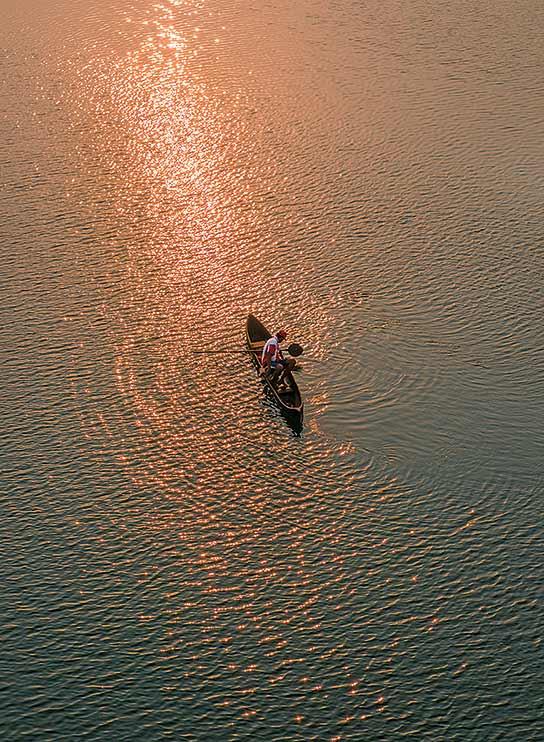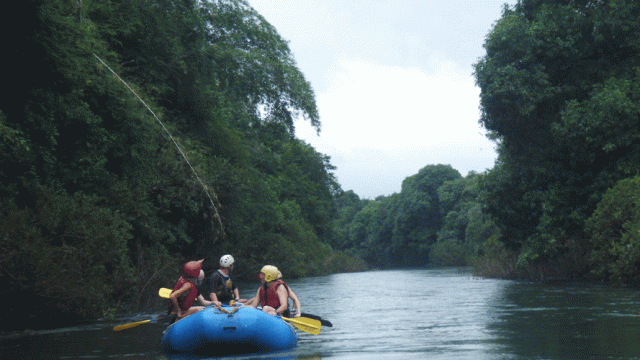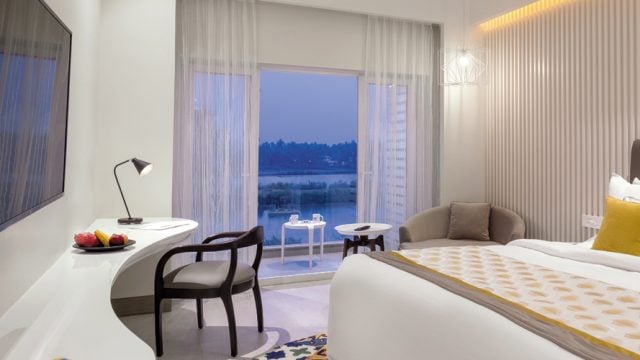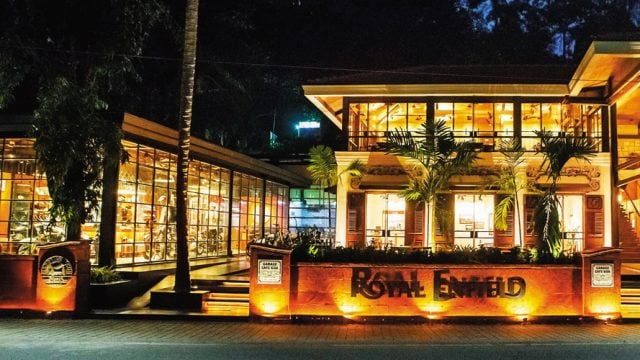I’ve known rivers: Ancient, dusky rivers. My soul has grown deep like the rivers. – Langston Hughes I am swimming far,
Lap. Lap. Lap. With every stroke, I leave something behind, grow lighter. As I feel my body dissolve into this bliss, I wake up. What, river-dreaming again? But before I can figure out what in the world is happening, I’m underwater, millions of tiny air bubbles floating up around me. It takes a moment to make sense of all of this and to realise I had fallen asleep while floating on my back in the Olaulim Creek, safely cocooned in the shade of the mangroves. Within a second my feet find the bed of slippery mud and I’m out again, only to find the crows perched in the trees having a good laugh at me. Okay, my friends, laugh away. All you are getting for dinner is a beakful of earthworms. My dinner, a juicy fresh fish, caught in these waters and seasoned perfectly, is even now slowly roasting — carefully wrapped in a banana leaf — on the grill back at camp.
I hold my head up high during the long swim back and arrive elated, albeit with a stiff neck and mud-caked feet. My hosts, at the magical Olaulim Backyards, tell me I have dared swim where no one dared swim before. Yes! I am a champion, the Queen of Olaulim Creek. But next time, they suggest, take one of the easy-to-use boats if you are planning to nap out on the water.
Chapora, Zuari, Mahadayi, Sal. Galgibag, Terekhol, Talpona, Saleri: these are the waterways of Goparashtra, coursing from the source, pulsating and free. Start by saying their names out loud as you read them, softly. See how the ancient names roll off your tongue and leave you feeling slightly flushed. To truly immerse yourself into the rivers of Goa is a bewitching affair. The gentleness of their flow is deceptive — they will awake within you a fierce longing which, in turn, only they can quench.
And if all of this lyricism speaks to you not, let’s come down to earth: everyone knows the classic Goa Beach Holiday is over. I mean, it can still be done, the way a coconut can be pressed a third time after the tasty, rich cream has been siphoned off. Sorry to say, but the tourists on the beaches these days resemble nothing more than tomb diggers, trying to uncover treasures that are by now a distant rumour. Here, on the other hand, inland and riverside, nothing will remind you of that reality: the traffic and crowds, the empty bottles, that certain type of visitor with the vehicle too-wide-for-the-road looking for some exposed skin; the music blaring from clichéd shacks as you sit in your cookie-cutter sunbed fighting off the endless salespeople with multi-coloured plastic noisemakers. So come on, be clever, turn your back on the beaches and face inland instead, vowing to come and go without laying eyes on the ocean.
The ride to the village of Olaulim is beautiful. We have been counting rivers, creeks and streams on the way, sparkling and gleaming in the sunshine. Several minutes after leaving the airport we had our first encounter: the Zuari, strong and broad, flowing from the Western Ghats down to the sea. When the road crossed over her, strong steel bridge suspended over sparkling blue body, we regretfully watch her disappear into the jungles and hills of the east. Twice, we stopped by the water’s edge: once to buy and drink tender coconuts from an old woman who seemed to know we were coming before we even knew it ourselves. We stopped once more, to photograph an impossibly pretty scene of birds perched on the red retaining walls and their reflections in the emerald green water. We feel positively giddy with our rebelliousness as we turn east instead of west to the beaches, and take the road less travelled inland, past ancient fields of rice and dense green hills, past villages with names like Ukasaim and Bastora, and into Olaulim, a village of fine old houses and distant vistas, surrounded by jungles of jackfruit, mango, cashew and bamboo. Olaulim Backyard, Peirko and Savio Fernandez’s eco-retreat, is built by the edge of the village, right down creek side.
As soon as we arrive, we know we will never want to leave. Peirko shows us to our bungalow, one of three built right into the red boulders of the hill behind the property. It is exquisite, built simply of natural materials and yet aesthetically delightful, as comfortable as one could be while this close to, indeed merged in, nature. The outdoor common eating area is in the same rustic but fully comfortable style as the bungalows, and Peirko’s food is homemade and delicious. In the evenings, Savio takes charge of the catch of the day. There’s no TV and no wi-fi; entertainment includes the family donkey’s many escapades, swims in the creek and in the lagoon-shaped pool, short or long excursions on the paddleboats and kayaks and watching the clouds merging and converging in the pastel sky. At night, long after even the crickets have gone to bed, we sit on the little dock, nursing our port, dipping our feet in the cool water.
By now, you crave to make closer contact with the water, to travel the waterways more deeply inwards. Sea Eagle Cruises offers several different trips, lasting anywhere from an hour to a full day. The road along the river to the Jetty in Brittona goes through a Goa most tourists never bother to see: fisherfolk’s homes, colourful tulsi shrines in the bustling inner courtyards; family-owned bakeries hidden between the walls of the homes. We pass sweet-faced kids in checked uniforms and oiled hair, holding hands as they walk past crosses and cows on their way home from school.
But when we board the Sea Eagle, we feel ourselves to be every bit as chic as tourists in Monaco or Cannes. Yes, today we are members of those classes, the ones who wear white and blue linen and take their martini dry, very dry. The staff is politely professional, the boat comfortable and we are offered our first round of drinks — wine, breezers (what, no martinis?) and lemonade. Our anticipation grows as the cap’n heads out into the beckoning, mysterious hinterland. Slow at first, soon we pick up speed and the pale green water sprays our willing sun-kissed faces. Underwater, schools of fish compete impetuously with the speed of our boat; out in the fallow fields, still as a postcard but for the wings of three great eagles, countless seeds bide their time, awaiting the monsoon’s first showers.
As our boat reaches the deep backwaters, the captain cuts the engine and lets us float, float, quietly down a narrow canal. Lulled into a deep peace, we have no sense of the passing time. Even talk of crocodiles does nothing to dispel the spell, and when a train chugs by on a vast bridge over the water, we wave to the passengers, imagining ourselves to be time travellers from Goa’s distant past. When the captain turns around we nearly hijack the boat, such is our need to stay out on the river. We eat our dinner at A Tona, a delightful little place right down the road, across the way from Panjim with the grand Mandovi between us. The young proprietor and chef, the daughter of an illustrious Goan family, specialises in Portuguese dishes: these are fresh and flavourful, but we preferred her Goan dishes for their spicy kick. We eat out on the open terrace, the colourful lights of the city twinkling across the way. The scene is both larger than life and sweetly cosy and we sit there for hours, happy to be exactly where we were.
When I wake the next morning I don’t know where my body is. I would panic if I weren’t so profoundly relaxed. Finally, I find my hands and feel under the sheets and lo! there I am. Who is this mellow, smooth creature, surrounded by bird song, tickled by breeze and as hungry, I now realise, as a horse? And is there time for a dip in the creek before breakfast? Ah, too many questions for this quiet mind of mine.
We don’t really feel the need to do anything besides swim in the creek and the infinity pool, eat Peirko’s food and try our hand at a river poem or two. We have brought drawing books and pastels, and have been sketching the creeks and backwaters — yellows and blues, greens of many hues. We have been trying (lazily) for days to catch, with our brush or our pen, something of the reverie we feel, the sense of oneness with the water, the wispiness of the present moment infused with a rich ancientness, arranging and rearranging our words and the colours. But today, we give in to our sense of adventure and rent bikes (well, Activas), and go explore the Chapora river up by the town of Aldona, travelling back through country roads along the water, crossing ferries back and forth for the fun of it. In the village of Siolim, down by the old ferry dock, (defunct now after the bridge to North Goa was built several years back) the old ladies still sell their papayas; men who have seen their fortune come, then go again, sell batter-fried chillies and fish curry to the old timers who haven’t forgotten. We leave our packed picnic on our motor bikes and order pao bhaji in a stall by the water. By the time our chai comes, the water has turned lilac and peach in the late afternoon light.
Dinner at J & A’s, overlooking the Baga Creek. This is as far west as we will travel on our river holiday, and even this excursion we treat as a naughty treat, a teasing of the boundaries, because a few moments further west from here lay that world we will not speak of in this story. But to be in Goa and to miss dinner at J & A’s is out of the question. Dinner here, in the open-air courtyard, the creek flowing by illuminated by the moonlight is always a treat; the food always delicious, the service genteel. Ask Jamshed about his motorcycle adventures or Ayesha about her newest culinary passions and you will be sure to win their favour. Don’t tell them we said so, though.
We are headed back to our hotel. We are staying the night at The Sofala on the banks of the Nerul river. Recently renovated, the swimming pool and deck of this chic boutique hotel face the river, fringed with coconut trees. As we cross over the bridge, the river flowing below us into the outstretched night, we admit to ourselves we will never write a poem or sketch a drawing that could reflect even something of this beauty. No option but to carry it home in our hearts.
The information
Getting there
When you’re in holiday mode, all roads (and flight paths) lead to Goa. Fly in direct from Delhi (from approx. Rs 5,000), Mumbai (from Rs 2,000), Chennai (from Rs 2,800), Bengaluru (from Rs 2,800), and other cities.
Where to stay
Casa Colvale: All of the pros of a stylish laidback stay in Goa without any of the cons. With its plush yet elegant river-facing rooms and chic outdoor eating and lounging areas, this is as close to the river you can be without actually getting wet. Food is an eclectic, carefully chosen mix of cuisines. Picturesque Colvale village, to the north of Mapusa, is wonderful for walking and chatting up neighbours but you’ll have to pass on the nightlife. A sister property, the popular Casa Britona, on the banks of the Mandovi, will suit those who want to be closer to the action.
TARIFF double rooms at both properties from Rs 3,700 in low season CONTACT 0832-2416737, casaboutiquehotels.com
Villa de Penha: Recently converted, this is now a hotel right on the Mandovi, in Brittona village—barely a ten-minute drive to Panjim, but safely on the other side of the river. The rooms are nice enough, and all have sitting areas facing the river; the spa is simple but full-service; and they have their own private jetty from which you can embark on a boat trip upriver or into Panjim.
TARIFF from Rs 4,000 doubles CONTACT 6710555, villadepenha.com
Olaulim Backyards: Go here once, and never really leave. The Fernandez family will stay in your hearts, along with the comfortable rooms, the great food and, most of all, the peace down by the creek.
TARIFF from Rs 3,500 doubles CONTACT 932601773, olaulimgoa.com
Avanilaya: Two gorgeous villas, spacious and in impeccable taste, situated over the Chapora river on a hillock outside Aldona. If you are looking for a romantic holiday, and if you can afford it, this is the place.
TARIFF from Rs 6,000 doubles CONTACT 2484888, avanilaya.com
The Sofala: This renovated 20-room boutique hotel overlooks the Nerul river. The pool and restaurant deck face the tranquillity of the creek, while indoors all is cool and elegant. A well-regarded new chef will be cooking up Italian food; and on Thursdays, as always, jazz all night.
TARIFF from Rs 3,300 doubles CONTACT 6714141, thesofala.com
Where to eat
Wok & Roll: Lovely location on the river at Sinquerim, on the road past the Taj. Pan-Asian food with a twist, the food is good and the prices fair. The best part is the complimentary appetizer: spinach leaves with small bowls of condiments to wrap inside (fried onion, peanuts, tamarind sauce and more). There’s a Sunday brunch too. After your meal, continue a bit downriver and come to the Sinquerim Jetty from where tourist boats leave regularly for crocodile cruises and river trips. (9049022348, woknroll.in)
A Tona: In Betim. Order anything you want but if you want to be smart, listen to the waiters and order the day’s recommendations. Plan to sit and enjoy for hours, nurse your drinks slowly and watch the play of colours on the water. Mesmerising. (9326122282
J & A’s: On the Baga Creek. We love everything on the menu, but make sure you finish with some chocolate mousse. Reservations recommended, but if you are in the area and want to pop in, there might always be a table for you. (9823139488)
Terry’s: Right on the Betim-Panjim Ferry crossing, on the Betim side. This is a great place to eat that most tourists never even notice, when it’s right under their noses. The seating is comfortable, there are perfect views of the Mandovi and the menu is extensive and excellent. After your meal, catch the ferry to Panjim, take a walk along the river and catch the ferry back again for a perfect outing. (2411961)
What to see & do
Go river rafting. If you are in Goa and want to “do something”, do this. An afternoon of white water rafting with John’s river rafting operation, which he now runs in tandem with Goa’s tourism department, is an absolutely delightful way to be out in nature, feel the cool sweetness of the river water and laugh like you may not have in a long time. The ‘rapids’ are not all that rapid but enough to make you miss a heartbeat or two. The rafts move along on the flow of the river, passing jungle and small white beaches, fully pristine, on the way. No experience necessary, the fab crew teach you everything and do their best to keep the whole experience upbeat and refreshing. Highly recommended (but runs only in the monsoon). Sign up on the Goa Tourism website (goa-tourism.com).
Take a Sea Eagle Cruise. There are several other river cruises but we loved the Sea Eagle and their staff. It is possible to spend the entire day out exploring the backwaters or you could take a shorter, one-hour sortie. TARIFF Various cruise packages on various rivers are on offer, but an indicative rate is Rs 25,000 for a 3hr cruise for a group of 12; includes snacks and beverages CONTACT 9595553799, seaeaglecruises.com
Visit the Salim Ali Bird Sanctuary. Take the ferry from Ribandar over to the river island of Charao. The walk in the bird sanctuary is surprisingly lovely: mysterious, shaded by mangroves and full of birds of all colours and sizes.
Goa Tourism
travelogues
waterdays in Goa
Leave a Reply
You must be logged in to post a comment.





